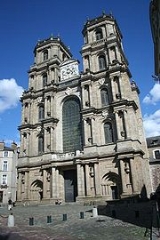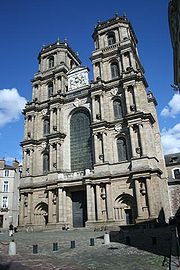
Cathédrale Saint-Pierre de Rennes
Encyclopedia



Cathedral
A cathedral is a Christian church that contains the seat of a bishop...
, and located in the town of Rennes
Rennes
Rennes is a city in the east of Brittany in northwestern France. Rennes is the capital of the region of Brittany, as well as the Ille-et-Vilaine department.-History:...
. It is a monument historique
Monument historique
A monument historique is a National Heritage Site of France. It also refers to a state procedure in France by which national heritage protection is extended to a building or a specific part of a building, a collection of buildings, or gardens, bridges, and other structures, because of their...
since 1906..
It is the seat of the Archbishops of Rennes, previously Bishops of Rennes.
Building history
The site has been used for a cathedral more or less from the beginnings of the see in the 6th century. The earliest building was completely replaced by a GothicGothic architecture
Gothic architecture is a style of architecture that flourished during the high and late medieval period. It evolved from Romanesque architecture and was succeeded by Renaissance architecture....
cathedral in the 12th century, of which in 1490 the tower and the entire west front collapsed. The existing façade with its neoclassical
Neoclassical architecture
Neoclassical architecture was an architectural style produced by the neoclassical movement that began in the mid-18th century, manifested both in its details as a reaction against the Rococo style of naturalistic ornament, and in its architectural formulas as an outgrowth of some classicizing...
granite
Granite
Granite is a common and widely occurring type of intrusive, felsic, igneous rock. Granite usually has a medium- to coarse-grained texture. Occasionally some individual crystals are larger than the groundmass, in which case the texture is known as porphyritic. A granitic rock with a porphyritic...
towers in four stages was constructed over the next two centuries or so, with long gaps between the different stages: the lowest level was built between 1541 and 1543, the second from 1640 to 1654 (by Tugal Caris), and the fourth (by Pierre Corbineau) from 1654 to 1678. Yet another architect, François Hoguet, completed the towers, between 1679 and 1704, at their present height of 48 metres and added the device of Louis XVI between them.
The nave and choir however had not been restored. During vespers
Vespers
Vespers is the evening prayer service in the Western Catholic, Eastern Catholic, and Eastern Orthodox, Anglican, and Lutheran liturgies of the canonical hours...
on 11 February 1754 a great stone fell from the roof of the choir, and it was decided, before the entire body of the cathedral collapsed, to demolish all these parts and rebuild them. The demolition was carried out between 1756 and 1768, leaving only the towers and west front standing. Rebuilding began in 1787, shortly after which the French Revolution
French Revolution
The French Revolution , sometimes distinguished as the 'Great French Revolution' , was a period of radical social and political upheaval in France and Europe. The absolute monarchy that had ruled France for centuries collapsed in three years...
began and all work was suspended. It did not recommence until 1816, initially under the supervision of the architect Mathurin Crucy
Mathurin Crucy
Mathurin Crucy was a French architect and urban planner, who conceived a major Neo-Classical architectural programme for Nantes which deeply marked the town.- Life :...
. He died in 1826; the work was continued under the local architect Louis Richelot, and finished in 1845.
The original decoration was in a plain neo-classical style, but during the 19th century it was extensively refurbished with gilt, stucco and paintings (inspired by those in the Parliament of Rennes)
to create a more sumptuous appearance. Characteristic of this cathedral is the contrast between the rich decoration, including, in front of the altar, slabs of rare marble from the Roman Forum
Roman Forum
The Roman Forum is a rectangular forum surrounded by the ruins of several important ancient government buildings at the center of the city of Rome. Citizens of the ancient city referred to this space, originally a marketplace, as the Forum Magnum, or simply the Forum...
, a gift from Pope Pius IX
Pope Pius IX
Blessed Pope Pius IX , born Giovanni Maria Mastai-Ferretti, was the longest-reigning elected Pope in the history of the Catholic Church, serving from 16 June 1846 until his death, a period of nearly 32 years. During his pontificate, he convened the First Vatican Council in 1869, which decreed papal...
, and the sombre granite of the structure.
Pro-cathedral
Between 1803 and 1844, because the cathedral was unusable, the abbey church of Notre-Dame-en-Saint-Melaine served as a pro-cathedralPro-cathedral
A pro-cathedral is a parish church that is temporarily serving as the cathedral or co-cathedral of a diocese.-Usage:In Ireland, the term is used to specifically refer to St Mary's Pro-Cathedral in Dublin, the seat of the Roman Catholic Archbishop of Dublin since the Reformation, when Christ Church...
(ie. a substitute).
This church is dedicated to Saint Melaine
Melaine
Saint Melaine was a 6th century Bishop of Rennes in Brittany .-Traditional history:...
, traditionally the first Bishop of Rennes, buried here in the 6th century. The present buildings were constructed in the 17th century, and were badly damaged during World War II
World War II
World War II, or the Second World War , was a global conflict lasting from 1939 to 1945, involving most of the world's nations—including all of the great powers—eventually forming two opposing military alliances: the Allies and the Axis...
.

